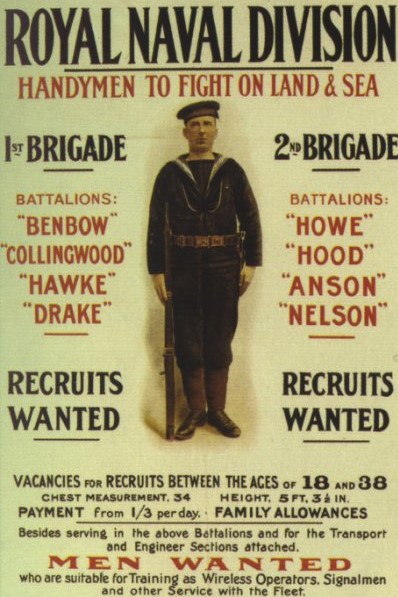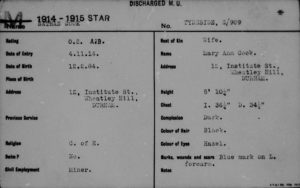To most Wheatley Hill folk of a certain age, ‘The Dardenelles’ is just the curious nickname for those many rows of identikit colliery houses that used to be at the back of the village’s front street. But to one local man the name meant something much more: for this was the theatre of war in which he was erroneously reported killed in action in 1915. His family received the terrible news that he had died; and then, weeks later, the brilliant news that he had survived. Though the latter fact didn’t quite carry forward to the day, many years later, when his name was solemnly inscribed on the Wheatley Hill War Memorial! An email out of the blue from Canada and some lucky finds in his service record later, and this is what we now know of his story.
William Wilson was born at Wheatley Hill at the end of 1877. He was one of the 11 children of John and Dorothy Jane Wilson, nee Cook and he was baptised into St Bartholomew’s Church, Thornley. His father was a quarryman. Both parents were from Shotton and had married in 1862 at the Anglican church of St Mary, Easington Village.
William married Marian Lawson on 23 September 1905 at the Anglican church of the Venerable Bede, Monkwearmouth, Sunderland. They were both living at different addresses in Hood Street, Sunderland at the time of their marriage and William was working as a quarryman. By 1911 William, Marian and their three children had moved from Sunderland and were living at No 2 Patton Street, Wheatley Hill.
At some time between the 1911 census and 1913 the family had moved again, within Wheatley Hill, to No 4 Emily Street and William joined the Royal Navy on 14 November 1914 and was assigned the service number Tyneside Z/998. Aged 37 in 1914, he was fairly old for a new recruit and even older for the branch of the service in which he eventually served, as a naval infantryman. We can speculate that he shaved a couple of years off his age on enlistment: his military records list his date of birth as 16/10/79.

We know from his enlistment information that he was a member of the Primitive Methodist religion, a coal miner, he was 5’5” tall with brown hair and blue eyes. Wilson joined the Hawke Battalion of the Royal Naval Division. During WW1 the RN had several battalions of sailors serving as infantry. These were distinct from the Royal Marines: they were sailor soldiers: thus Wilson’s rank was Able Seaman.
Wilson was reported killed during the ill-fated Gallipoli Campaign, on 16 June 1915. His next of kin (wife Marian) was advised of his death. His record then states that on 7 July 1915 the Royal Naval Division realised they had made a mistake and William was not the William Wilson who had died in the Dardanelles on 16/6/15 and they informed Marian on 18 August that he was “previously reported killed now reported alive and well”. The actual William Wilson who had died was another William Wilson who was serving in the same Battalion and who had also enlisted on Tyneside. As the official record states, he was “confused with W Wilson, Tyneside Z/838” of Hexham, who died on 6/6/15, aged 23, and who is commemorated on the Hellas Memorial, Turkey.
Meanwhile ‘our’ William Wilson continued fighting, but in August 1915 his luck finally ran out when he suffered a ‘bomb wound’ (ie grenade shrapnel) to his left thigh at Gallipoli. He was evacuated on the hospital ship Rewa and subsequently invalided out of the service due to his wounds and, eventually, returned to Wheatley Hill.
On 30 July 1916, Wilson was Mentioned in Despatches in the London Gazette for his bravery during the campaign, one of only 11 Hawke Battalion officers and men so honoured and one of only two Able Seamen—the other was Able Seaman Nathan Cook, Tyneside Z/909, also of Wheatley Hill.
Whilst researching for the history club book, The Employees & & Residents of Thornley, Ludworth and Wheatley Hill – Their Contribution to the First World War, back in 2005 our researchers came across a newspaper report of the death of William Wilson of Wheatley Hill and he was added into the chronology of events in the three villages. However, a later report, ‘previously reported killed, now reported alive and well….’ did not come to their attention, understandable perhaps given the huge amount of casualty information which they had to sift through.
And so, erroneously, a ‘William Wilson’ was entered into our records as being killed in the First World War. He also appeared on the History Club World War One web site and, as our research was used by the Parish Council to update the War Memorial, he appears on there, too.
Then, in June 2021, the History Club was contacted by a lady in Canada querying the inclusion of William Wilson on our website as a WW1 fatal casualty.
William was her grandfather and, apart from telling us that he did not die until 1939, at Fylde, Lancashire, she also felt it unlikely that he had been involved in the War at all as it had never been mentioned in her family. She was surprised when we were able to tell her that William had been Mentioned in Despatches for his gallantry at Gallipoli and was subsequently presented with a gold watch by the Heroes’ Distinction Committee in Wheatley Hill in 1919. See our book, page 198.
So, in the book, we had, incorrectly, a William Wilson of Wheatley Hill who supposedly died in 1915, but also, correctly, another William Wilson who was honoured by the village on his return, who survived. And only now do we know that they were one and the same man.

Re-reading the WW1 book, another detail now suddenly cries out: on page 111, a news item reports that Able Seaman Nathan Cook, of 12 Institute St, Wheatley Hill, was awarded a Certificate of Merit for ‘zeal and devotion to duty on 31 July 1915 while serving with the Hawke Battalion on the Gallipoli Peninsula.’ Cook was born in 1884 and enlisted in the RND on 4/11/14.
So, Cook and Wilson were both serving in the Hawke Battalion in 1915. Two Wheatley Hill men serving in the same Royal Navy battalion of around 800 men. It’s almost inconceivable that they didn’t know each other. Wilson’s mother’s maiden name was Cook. Were they relatives and did they volunteer together? That, perhaps, is the beginning of another story. Significantly, Cook’s service number is Tyneside Z/909, just 89 off Wilson’s. Next to Wilson’s number is Thomas Clish, Tyneside Z/999, of 12 Gulloch St, Wheatley Hill. He lists his date of birth as 14/2/79. It was actually 1878, so he shaved a year off his age too.
And next to Cook is George Bradwell, Tyneside Z/908. His service record lists 13 Doctor Street, Shotton Colliery as his home address but written in pencil at the side is 13 Twelfth St, Wheatley Hill. His date of birth is 18/1/80.
Put a hundred or so raw recruits together and we can imagine the busy scene at a Royal Navy induction centre, sometime in November 1914, Cook at one end of the line having his service number assigned and Wilson at the other. A group of eager young–and not so young–men bravely volunteering for what-ever the new World War will throw at them. Both men were Mentioned in Despatches. Both came home. Both deserve to be remembered. And one came back from the dead—twice!
For more on the Royal Naval Division at Gallipoli see this excellent web site. The specific page below includes a listing of Wilson and Cook’s ‘Mentions’:
https://www.naval-history.net/WW1Battle1503Dardanelles2.htm#29541
by Margaret Hedley and Tom Tunney